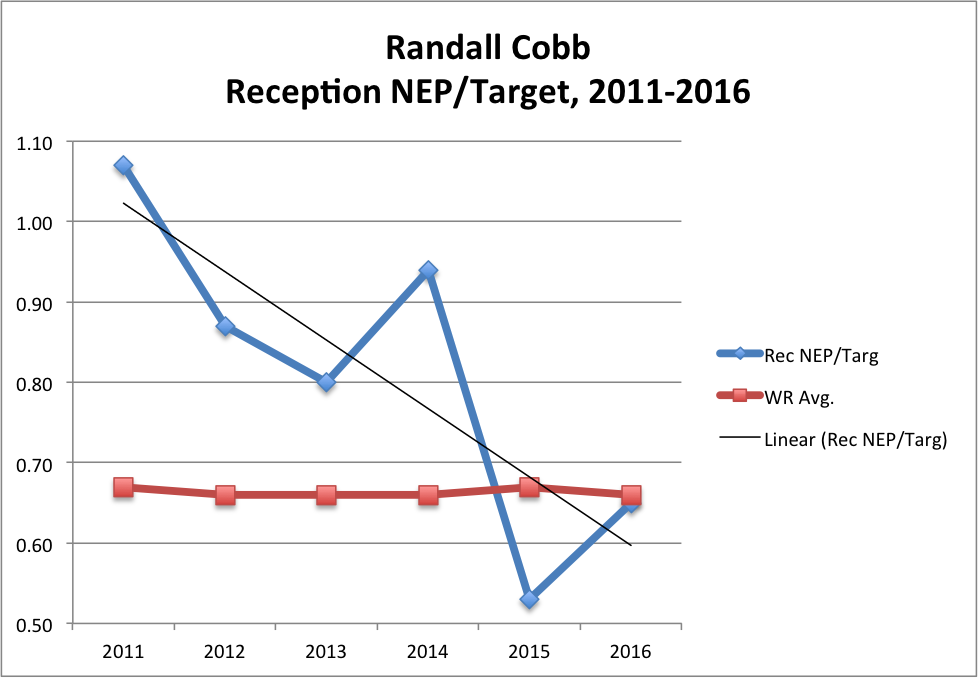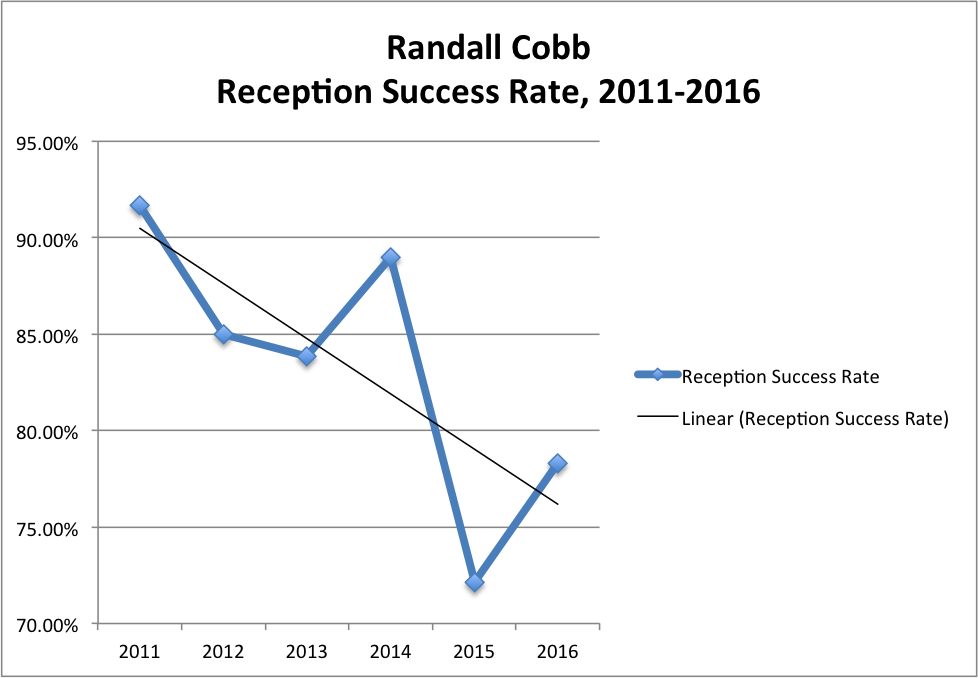Randall Cobb Isn't Good Anymore

I cannot say that I’ve been able to watch the movie Toy Story 3 a single time without tearing up a bit.
I -- like the toys’ owner Andy -- had always imagined that my action figures got into their own adventures when I was asleep or away. This movie series struck a chord with me as a child, so when it showed the end of Andy’s childhood in the third installment, I had that same sense of nostalgia -- loss and appreciation simultaneously.
While the Green Bay Packers may have nostalgia for the playing contributions of wide receiver Randall Cobb, they are starting to outgrow one of their favorite receivers.
Cobb has proven to be one of the best complementary wide receivers in the NFL, but in recent seasons he hasn’t been able to tow the line as a true team-leading receiver. When injury struck Jordy Nelson two years ago, Cobb did not step up in the way a true receiving threat needed to.
Time touches us all, and the Packers are no longer who they were five years ago; is it about time they part ways with their old friend, Randall Cobb?
You’ve Got a Friend in Me
The Packers know that their youth -- and that of quarterback Aaron Rodgers -- is rapidly slipping away as each year delivers another bungled playoff appearance. Each year rips away one more chance for a Super Bowl title with their current core.
Injuries happen and there’s no way to plan for them, but when one of the best passing offenses in the league derails because one player is out, that’s not a good sign. That’s what we saw in 2015, when Nelson tore his ACL in the preseason and was out for the year. The Packers’ “next man up†ideology had Cobb simply stepping up into the top receiver role and thriving due to added volume, but -- to make a long story short -- that didn't happen.
We can see just how futile Cobb's season was through the help of numberFire’s signature analytic, Net Expected Points (NEP).
NEP is an analytic that describes the contribution a play (or player) makes to their team’s chances of scoring. By adding down-and-distance value to standard box score information, we can see just how much each play and each player as a whole influence the outcome of games. For more info on NEP, check out our glossary.
The graph below shows the trajectory of Cobb’s annual Reception NEP per target since his rookie 2011 (the red line is the league average for wide receivers). How badly has he begun to perform?

As you can see, it’s not that he’s begun to play poorly; nearly every year has been a step down in quality and efficiency for Cobb. While we can attribute some of that lag to a surge in volume of targets (30 in 2011 to an average of 128 over 2014 and 2015) normalizing his rates, he’s also just been much less successful on the field at converting value, and he's been used in a more limited role.
Cobb has become the consummate short-area receiver -- and by that I mean he catches the ball short and falls down. The graph below shows Cobb’s Reception Success Rates -- the percent of receptions resulting in positive NEP -- over the last six years.

The arc of Cobb’s Reception Success Rates is almost identical to that of his Reception NEP per target.
What does this mean? Cobb, as a smaller slot receiver, is no longer being sent on deep routes, and he’s not been able to break big plays on short receptions. In fact, though Cobb has 10 touchdowns over the last two years, 9 of them have come from passes on the opposition’s 10-yard line or closer.
Cobb is being used solely as a short-area checkdown option (low value per target), and he hasn’t had the juice to reliably turn that steady stream of targets into positive value (low success rate). He's just not enough to lead a receiving group, and that has finally been exposed.
Falling With Style
Even when we try to give Cobb the benefit of the doubt with context, we find that he’s just not what we thought he’d be anymore.
When relating Cobb’s production to the other Packers’ receivers, he still has looked atrocious over the past few years -- and it’s put in even starker relief. The table below shows the difference in percentage between Cobb’s Reception NEP per target and Reception Success Rate and the team averages in these analytics (with a negative number meaning he was worse than the team average).
How much worse has he been than his teammates?
| Year | 2011 | 2012 | 2013 | 2014 | 2015 | 2016 |
|---|---|---|---|---|---|---|
| Rec NEP/Target | 5.94% | 7.41% | 2.56% | 11.90% | -11.67% | -13.33% |
| Rec Success Rate | 1.66% | -2.51% | -3.26% | -1.38% | -9.81% | -7.78% |
Cobb has been significantly worse than the team average at receiver over the past two years, but his Reception Success Rate was below average even before then. He has never been a special talent; he plays in a special offense and had a few years of elite usage.
Even when we compare apples to apples by looking at the 28 most highly-used slot receivers on each team this year (some didn’t have a slot receiver with over 50 targets), Cobb doesn’t stack up so well: in terms of Reception NEP per target, Cobb was 15th, and by Reception Success Rate, he was 21st. His catch rate was a stellar 10th-best, but that’s hardly surprising when he was running short routes on which Rodgers could underhand the ball to him.
At a cap hit of $9.15 million last year, Cobb was one of the least cost-efficient receivers in the league; compared to the 2015 data on this, only Calvin Johnson would have been worse. Cobb’s cap hit rises to $12.66 million this year; the Packers cannot afford to pay him that much for such little production.
To Infinity and Beyond
For fantasy players, we also need to start cutting bait on Cobb ourselves.
Cobb simply isn’t seeing the volume of targets he needs to as a limited player to return value for us in the fantasy world. He was targeted 84 times on his 624 receiver snaps (per Pro Football Focus), for a target rate of 13.46 percent in 2016. Among the 92 receivers last year to see at least 50 targets, that rate was the 10th-lowest, and it was actually worse than the likes of Philly Brown, Albert Wilson, and Victor Cruz.
There’s no reason to expect Cobb to bounce back in efficiency in his role with the Packers, especially if they can re-sign tight end Jared Cook to be the middle of the field deep seam-buster.
Cobb is a high-floor, low-ceiling fourth fantasy wide receiver, and our memories of his peak are really all that sustains the player we once thought we knew.
















